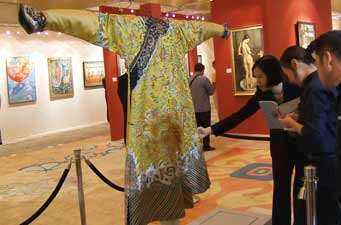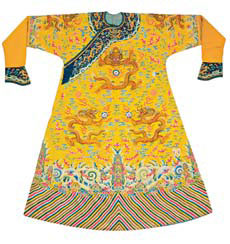| Tools: Save | Print | E-mail | Most Read |
| Emperor's Robe to Go Under Hammer |
| Adjust font size: |
But a dragon robe worn by Emperor Qianlong (reign 1735-1796) of the Qing Dynasty (1644-1911) is very much on show in Beijing to attract potential bidders at an upcoming auction. The robe, which looks almost new, was worn only on important occasions, such as his wedding, birthday celebrations and during rituals offering sacrifices to gods and ancestors, said Chi Fan Tsang, a specialist with international auction house Christie's. They will go under the hammer during the annual spring sale of Chinese art by Christie's in Hong Kong from May 27 to 31. Also on auction are paintings, calligraphy, ceramics and jade artifacts from the royal collection. The dragon robe, which is expected to fetch about HK$4 million (US$512,000), is the most well-preserved to appear on the world market, said Tsang. It's said by international auction house Christie's, they found this robe from an overseas collector and hope it can be bought by a Chinese museum or collector. Experts concluded that the robe was used for special ceremonies because it is embroidered with 12 symbols besides the usual nine dragons suggesting the attire of an emperor. The 12 symbols, such as an axe, a coral, and two cup-shaped containers with tigers inside, are small and hidden among dragons riding on clouds. Despite the intricacy of the craft, dragon robes or other textiles are not popular with Chinese collectors. Their beauty is appreciated mainly by foreigners, and sales of ancient Chinese textiles are often held in New York. "The Chinese believe that it is unlucky to have clothes worn by the dead," said Tsang. "But traditional notions are changing as more and more people go abroad and their taste becomes more international." The enthusiasm of collectors is important for the preservation of textiles, whose value is not as widely recognized as other kinds of cultural relics like ceramics, said Gao Feng, conservationist at the China Cultural Heritage Research Institute. For decades, the buyers of auctioned Chinese emperors' robes were mostly foreigners. Chinese collectors thought embroideries were commonplace, not very valuable, and difficult to protect. So most dragon robes were lost overseas. In recent years, when experts noticed some embroidery patterns and skills were nearly lost, Chinese collectosr began to pay more attention to textile collections.
(China Daily May 16, 2007) |
| Tools: Save | Print | E-mail | Most Read |
 |
| Related Stories |

